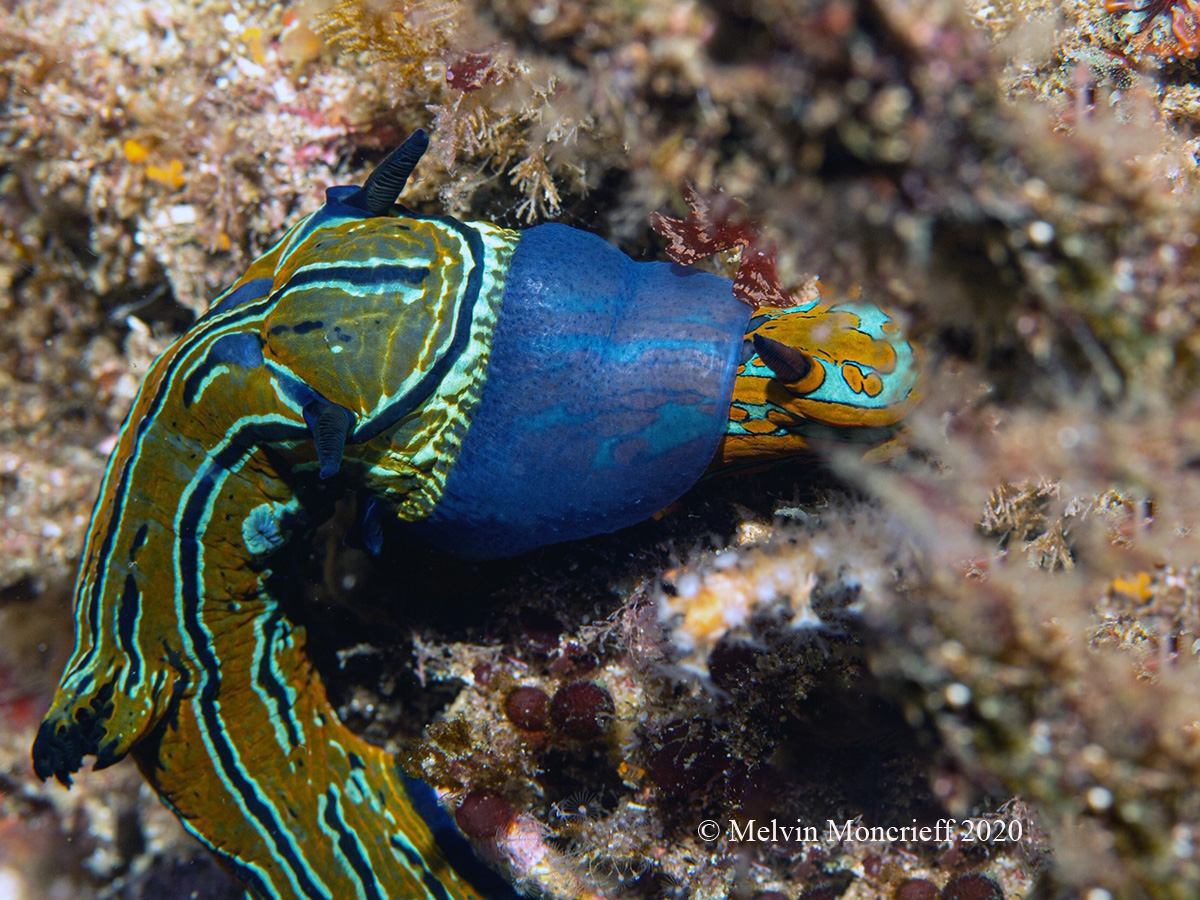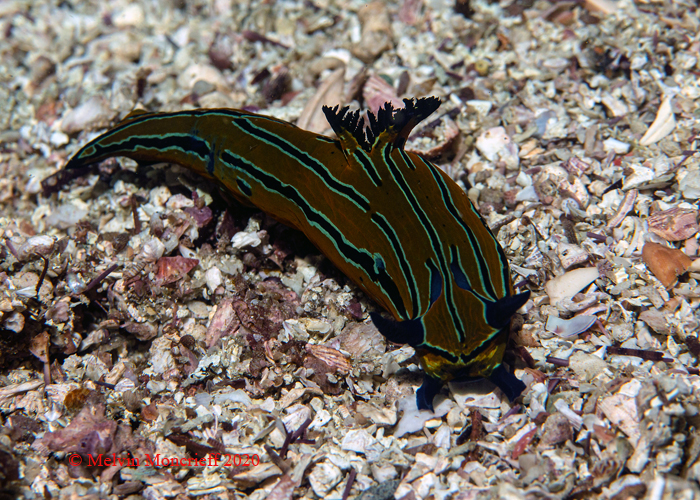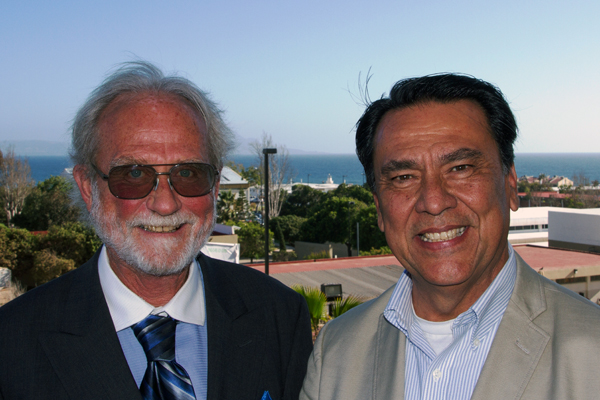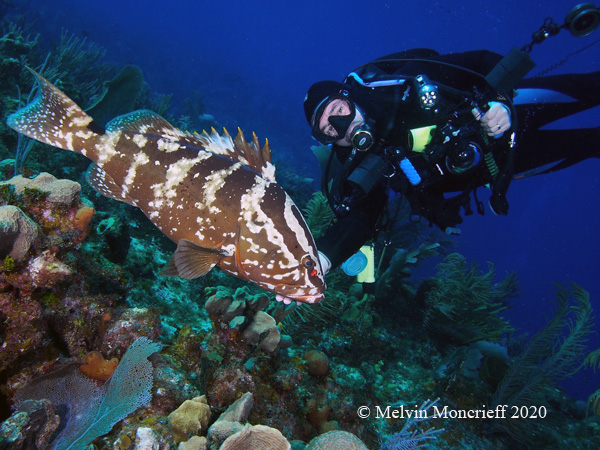 |
Image courtesy of Melvin Moncrieff
Midriff Islands, Baja California, Mexico, April 2020
Canon 70D
|
Image courtesy of Melvin Moncrieff Midriff Islands, Baja California  |
Roboastra tigris Farmer, 1978 Yes, We know Roboastra tigris has been published some time ago on the site, but how could we not revisit given the outstanding predation image above that Melvin Moncrieff sent in by way of John Greenamyer, a long time contributor to the Slug Site! Melvin's image is indicative of the life and death struggles that go on daily in their watery habitat. The photo shows R. tigris ingesting Tambja abdere Farmer, 1978. Although T. abdere has a chemical defense system, it seems too late for it to escape. Roboastra tigris also preys upon T. eliora (Marcus & Marcus, 1967), but that species has a different defense–it tries to swim away by violently flapping its body from side to side (illustrated in Bertsch & Aguilar Rosas, 2016, page 259). Roboastra swallows it prey whole. A rapidly outwardly-expanding deep blue buccal hood engulfs the prey animal, and it then uses its large hook-like radular teeth to pull the animal inside its mouth (see B & AR, 2016). Its preferred prey in the wild are the two species of Tambja. James Lance performed laboratory feeding experiments at Scripps Institution of Oceanography, and reported (Lance, 1997) that Roboastra tigris consumed 12 other species of Nudibranchia (both Californian and Cortezian species), and Aplysia californica Cooper, 1863. Methanolic extracts of all three nudibranchs contained “the tambjamines A-D (I-IV) which were traced to a dietary source, the ectoproct (bryozoan) Sessibugula translucens Osburn, 1950, and were implicated in the chemical defense mechanism of the Tambja species” (Carté & Falukner, 1983). The two Tambja species prey on the green encrusting bryozoan, which are in turn the preferred prey of R. tigris. These chemical metabolites are known to be fish feeding inhibitors (Carté & Faulkner, 1986). The high concentrations of the tambjamines in T. abdere sometimes causes the Roboastra to break off the attack. This chemical movement up the food chain was the subject of Brad Carté’s (1984) Ph.D. dissertation. |
Description: A well-fed individual of this truly impressive slug can reach up to 15 cm in total length. The body is an olive-green color; there are five lengthwise black stripes, each edged on both sides with a light green band. Two lateral in-rolled dark blue processes on each side of the mouth are probably chemosensory or tactile organs. Rhinophores and gill tips deep blue.
Distribution: From the central (Bahía de los Ángeles) and southern Gulf of California to Bahía de Banderas, Jalisco-Nayarit, México.
Taxonomic Notes: Willan & Chang, 2017, placed this species in their recently named new genus, Tyrannodoris, based on dissections and morphological comparisons from the literature and their work. “On account of rows of sensory pits all along the body (none being homologous with the pre-rhinophoral sensory organ) we suggest Roboastra sensu stricto should accommodate only the type species, the relatively small R. gracilis” (op. cit., p. 1). They re-positioned all other species previously identified as Roboastra into their new genus Tyrannodoris, with Tyrannodoris luteolineata (Baba, 1936) as the type species. It is important to note they performed no new dissections of any Roboastra/Tyrannodoris species. Two comments need to be made. 1) Based on the phylogenetic analysis of multiple character states, Pola, Cervera & Gosliner (2005) concluded, “Bootstrap support analysis shows that Roboastra is monophyletic....The tree is fully resolved and shows that R. gracilis and R. luteolineata, the Indo-Pacific species, are the [two most] basal species in the clade.” 2) In a phylogenetic analysis based on partial sequences of two mitochondrial genes and morphology for most species included in Nembrothinae, Pola, Cervera & Gosliner (2007) concluded that “Excluding one species (Tambja tentaculata), the monophyly of Roboastra was supported by all the phylogenetic analyses of the combined molecular data.” The following year (2008) these authors reported, “Based on morphological and molecular phylogenetic analyses, Tambja tentaculata Pola, Cervera & Gosliner, 2005, fits within the clade of Roboastra species. In order to maintain the monophyly of Roboastra, we transfer this species to Roboastra.” The un-refereed nature of this site precludes a taxonomic decision on the generic placement of tigris. Therefore the name commonly used by eastern Pacific researchers (Roboastra tigris) is used herein, based on the monophyly of the genus established in the Pola et al. papers.
Acknowledgment: Gary McDonald provided useful help with the references.
References
Bertsch, Hans & Luis E. Aguilar Rosas. 2016. Invertebrados Marinos del Noroeste de México / Marine Invertebrates of Northwest Mexico. Instituto de Investigaciones Oceanológicas, UABC, Ensenada, xxxii + 432 pp.
Carte, Brad Kevin. 1984. Cytotoxic metabolites from marine organisms. Ph.D. Thesis, University of California, San Diego, CA.
Carté, B. & D. John Faulkner. 1983. Defensive metabolites from three nembrotid nudibranchs. Journal of Organic Chemistry 48(14): 2314-2318.
Carté, B. & D. John Faulkner. 1986. Role of secondary metabolites in feeding associations between a predatory nudibranch, two grazing nudibranchs, and a bryozoan. Journal of Chemical Ecology 12(3): 795-804.
Farmer, Wesley M. 1978. Tambja and Roboastra (Mollusca: Opisthobranchia) from the Gulf of California and the Galapagos Islands. The Veliger 20(4): 375-385.
Lance, James, R. 1997. Potential prey of Roboastra tigris. Opisthobranch Newsletter 23(8):29-30.
Pola, Marta, J. Lucas Cervera & Terrence M. Gosliner. 2005. Review of the systematics of the genus Roboastra Bergh, 1877 (Nudibranchia, Polyceridae, Nembrothinae) with the description of a new species from the Galápagos Islands. Zoological Journal of the Linnean Society 144: 167-189.
Pola, Marta, J. Lucas Cervera & Terrence M. Gosliner. 2007. Phylogenetic relationships of Nembrothinae (Mollusca: Doridacea: Polyceridae) inferred from morphology and mitochondrial DNA. Molecular Phylogenetics and Evolution 43: 726-742.
Pola, Marta, J. Lucas Cervera & Terrence M. Gosliner. 2008. Description of the first Roboastra species (Nudibranchia, Polyceridae, Nembrothinae) from the western Atlantic. Bulletin of Marine Science 83(2): 391-399.
Willan, Richard C. & Yen-Wei Chang. 2017. Description of three new species of Tambja (Gastropoda, Nudibranchia, Polyceridae) from the western Pacific Ocean reveals morphological characters with taxonomic and phylogenetic significance for traditional Polyceridae and related ‘phanerobranch’ nudibranchs. Basteria 81(1-3): 1-23.
Imperial Beach, Calif
Sept., 2020
Send Hans email at hansmarvida@sbcglobal.net
Michael Miller
San Diego, Calif
Sept., 2020
Send Mike email at mdmiller1@cox.net
Photo by Craig Hoover.
 |
|
Image courtesy of Melvin Moncrieff |
I was raised in Southern California and introduced to nature at an early age. I wanted to learn to dive for as long as I can remember, but only got certified in 2007, after my wife and I did a Discover Scuba event off a cruise ship in the Turks and Caicos. Since then, I've been totally hooked, and logged over 1300 dives, from California to places as diverse as Indonesia (Komodo, Bali, and Raja Ampat), the Philippines, Fiji, the Caribbean, and Mexico, including both the Socorros, and the Sea of Cortez. I was already a pretty dedicated nature photographer when I started diving, so I knew underwater photography would be a big part of my diving, and even took down a small camera on my last open water certification dive (knowing what I know now, probably not a good idea). It took me a while to get over the sticker shock of uw photography gear, but I finally purchased an Olympus EM-5 with Nauticam Housing and Sea and Sea D1 strobes. That is the gear I'm pictured with in the two diving pictures. More recently, I broke down and bought a housing for my topside camera, a Canon 70D, and now use that, with the Tokina 10-17, and Canon 60 and 100 mm macro lenses. I'm more of a wide-angle specialist, but I love macro as well, and the more I learn about Nudibranchs, the more interested I become. My favorite place to shoot them has been in Anilao, in the Philippines, but I've also had some success here locally in SoCal, and in the Sea of Cortez.
|
